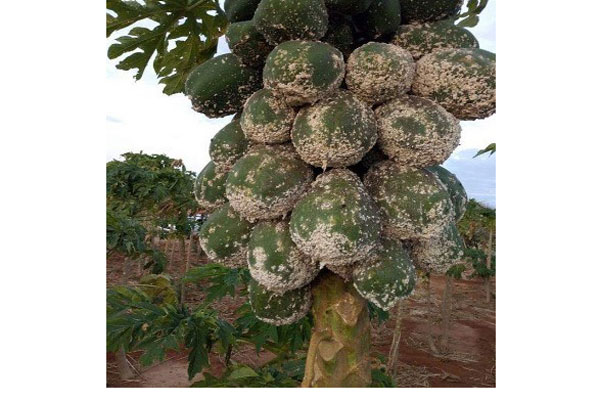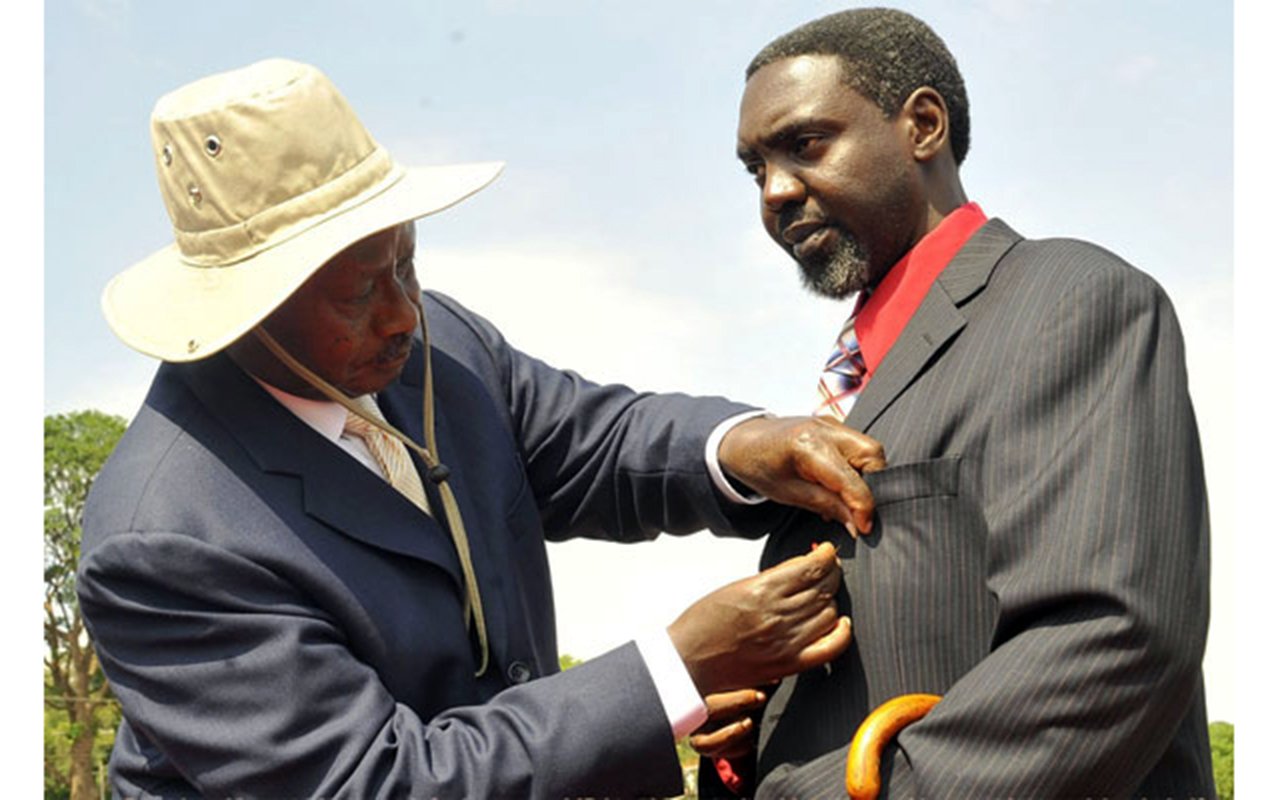Biological control to fight invasive pest in papaya

Papaya fruits infested by the mealybugs. Photo/Deus Bugembe
What you need to know:
The pest which was first detected in Uganda in 2012, is a small polyphagous sap sucking insect that attacks leaves and stems to suck on the sap, in the end it leaves the plants stunted, leaves deformed hence killing the pawpaw plant
Lawrence Sali Segawa has lived in Kayunga District his entire life, watching his grandfather and father survive off pawpaw farming.
Segawa too has picked up on the economic activity and become one of the leading farmers in the district.
Papaya mealybug
However, Segawa and fellow pawpaw farmers are facing the wrath of a stubborn insect pest, the papaya mealybug, and it has given farmers sleepless nights.
“We do not know how to handle it, we have sprayed but nothing changes. We have gone for recommended seeds but it still attacks, leaving us stuck at the moment,” he told Seeds of Gold at the validation workshop for the papaya mealybug bio control held at the Kawanda Agriculture Research Institute last week.
How it spreads
The pest which was first detected in Uganda in 2012, is a small polyphagous sap sucking insect that attacks leaves and stems to suck on the sap, in the end it leaves the plants stunted, leaves deformed hence killing the pawpaw plant. It leaves a mold on the leaves, making it hard for the photosynthesis process as the leaves are blocked from air and light.
The mealybug infestations are observed as clusters of cotton like masses, thus being locally known as “Kipamba” in Buganda region. Christine Nakijoba is another farmer in Mukono District who recently lost two acres of pawpaw to the papaya mealybug. “It has affected us so badly that one can fail to even yield one percent profit. People down there are crying because of unbearable losses caused by this pest,” says Nakijoba.
Spreads to other districts
Apart from Mukono and Kayunga, Lira and Luwero are the other districts under attack. “In Lira, we started experiencing it in 2019 and it caused very big losses. We have so far been taught how to identify it but how to treat it is still a myth,” says James Ogwang who was part of the survey team to examine the pest in Lira where many farmers have cut down the pawpaw trees. According to a survey by National Agricultural Research Organization (Naro), the average farmer cultivates the crop on 0.75-2.5 acres while bigger farmers can go up to 10 acres. Those numbers have been affected by the mealybug with low productivity and poor quality fruits. Trees even take longer to bear fruit and when they do, they last one season instead of five or more as it was before.
How to control the mealybug
When the papaya mealybug took its toll and left farmers helpless, something had to be done to stop it. The Ministry of Agriculture, Animal industry and fisheries along with Naro and Centre for Agriculture and Bioscience International (CABI), have set out on a mission to tackle the mealybug. A participatory rapid rural appraisal was conducted in Kayunga, Mukono, Lira and Luweero Districts to gain understanding of the presence, distribution and impact of the papaya mealy bug in the country as well as farmers’ management practices.
“We have had to share findings about the mealybug when we went to different farmers. It is evasive and very destructive yet farmers do not know how to manage it. We went down and found out what farmers are doing and it is time to sit with stakeholders and find solutions,” says Nakijoba. Stephen Byantwale Tibeijuka, the commissioner crop protection from the Ministry of Agriculture, Animal Industry and Fisheries is happy the solution finding process has kicked off and soon pawpaw farmers will have smiles back on their faces. “We are engaging with partners, districts, local governments and everybody about a new pest that has invaded our papaws. The papaya mealybug came to Uganda through Tanzania and it takes away money from farmers which Impacts on the economy. As government, when something like that comes in we come in to guide our farmers,” says Tibeijuka.
Advice
Farmers have been advised to report to the nearest extension workers to pick samples whenever they see something similar to mealy bug infestation. Identification remains the most important phase in fighting this pest. This can be done by identifying some signs such as yellow leaves, tasteless fruit, reduction in flowering and when all these are visible, farmers are advised to chop and burry to kill the pest. It has also been noted that pesticides might not be the best option as they can be poisonous. Apart from being poisonous at times, pesticides might not be able to access the leaves due to the pest’s waxy covering.
Biological control measures
At the end of the day, researchers arrived at the fact that application of biological control measures was the best bet on dealing with the papaya mealybug. A faction of the affected farmers questioned the approach, calling for proper testing and community level communications before the introduction of exotic natural enemies. Biological control is a method of controlling pests, such as insects, mites, weeds, and plant diseases, using other organisms. In this case, educating farmers will have to convince them that the method can work. It involves releasing of biological control parasitoids, these are small insects whose young stages develop either within or attached to the outside of other insects, referred to as hosts. Parasitoids eventually kill the host they feed on, as opposed to parasites like fleas and ticks, which typically feed upon hosts without killing them.
Natural enemies of the papaya mealybug include the mealybug destroyer (Cryptolaemus montrouzieri), lady beetles, lacewings, and hover flies, with a good track record of attacking the papaya mealybug and limiting infestation.




